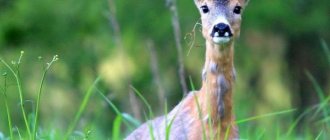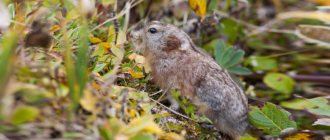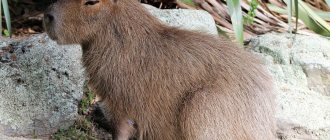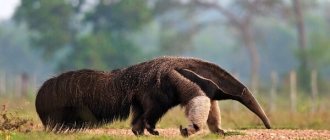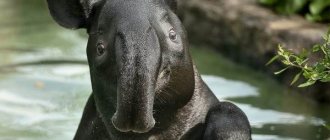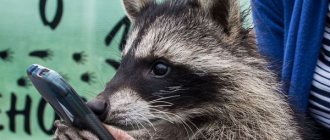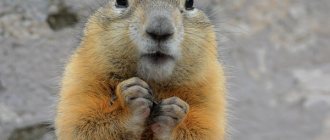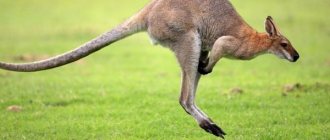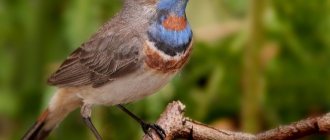- Difference from Lama
When Europeans first set foot on the American continent, a tremendous cultural exchange took place between the inhabitants of two continents previously separated by an ocean. Among the other “miracles” that the white people brought were horses that were previously unknown to the local Indians. But the inhabitants of South America, the legendary Incas and related tribes have long had their own worthy analogue
horses: llamas and alpacas. Alpacas are close relatives of llamas, attractive and peaceful pets, our article is about them.
Description, structure, characteristics
What does an alpaca look like? According to the legend of the Quechua Indians (descendants of the Incas), the alpaca was sent down by the gods themselves, or rather, it was she who accompanied the goddess Pachamama (the ancestor of all people) when she first appeared on Earth. The alpaca was chosen as the goddess's companion for her peaceful disposition and the great benefits she can bring to people. And indeed, in the life of the Incas and other South American Indians, the alpaca occupied (and occupies) the same importance as the horse, cow and pig in the life of our ancestors.
The alpaca is a distant relative of the camel and a close relative of the llama. It is believed that the alpaca is descended from the llama and many even confuse the llama and the alpaca. In fact, there is a difference between them, we will talk about the difference between them a little further in our article.
Alpaca is a calloused animal. What does it mean? The fact that, unlike the herbivores of the “old world”, they do not have hooves, and they walk relying on the phalanges of their toes. Instead of hooves, they have a calloused growth as a foot. And their two-fingered limbs have curved and blunt claws. Thanks to this unusual paw structure, alpacas, unlike sheep and goats, cannot trample pastures with their hooves due to the lack of them.
The weight of an alpaca is on average 60-70 kg, and the height at the withers reaches 1 meter.
The main calling card of this animal is its thick alpaca wool, which is black, brown or white. It is wool that represents the main value of alpacas. In ancient times, robes were made from alpaca wool for the Inca kings, priests and other noble nobles of the Inca Empire, while ordinary Indians were content with clothes made from llama wool. However, even in our time, alpaca wool is of great value, for example, its export is an important part
economy of Peru.
Interesting fact: alpaca wool retains heat six times better than sheep wool, while having a fine and delicate structure.
The upper jaw of alpacas is completely devoid of teeth, but the upper lip is designed like a camel's, it is powerful and forked. The lower jaw has incisors located at an angle. They are the ones who mow down the grass caught by the upper lip.
The alpaca's stomach, unlike other ruminant herbivores, consists of three sections, not four. However, the digestive system of alpacas is very efficient, so a pasture of 1 hectare will be enough to feed a herd of 20-30 individuals.
Another interesting feature of alpacas is their ability to live at high altitudes in thin air. Their lungs are designed in such a way that they can breathe the air there, and their warm wool perfectly protects them from low temperatures.
A haircut
Alpaca shearing is an art. Alpacas are sheared twice a year. Experienced shearers do this very carefully so as not to damage the fleece. During the first shearing, the animal is laid on its side, the front and hind legs are tied, and then it is clipped with an animal clipper. Usually adults get used to this process and then everything goes more peacefully, one holds the animal, the other cuts the animal. On average, about 5 kg of wool is obtained per haircut. Alpacas usually have three types of wool. From the back and from the sides the best, from the neck the second grade, from the belly and paws the third grade.
Of course, after shearing, alpacas do not look so attractive, but six grows back quite quickly and, taking into account the fact that shearing is done in the summer, by winter it completely covers the body from the cold.
In recent years, several alpaca breeding farms have appeared in Russia. True, this is associated with certain difficulties, but nevertheless, enthusiasts persistently continue to do this and it seems that they are not unsuccessful. Moreover, these llamas tolerate the Russian climate well and get along well with other animals. Moreover, thanks to their high growth, they can even protect sheep from predators. They run fast and even lone wolves do not pose much danger to them. With powerful long legs and teeth, they can easily fight back. By the way, alpacas do not have upper teeth, but only lower ones, and therefore they do not spit like llamas or camels. But in general they are very peaceful and good-natured animals.
Difference from Lama
Now let's look at the differences between a llama and an alpaca. Although these animals are close relatives and even interbreed with each other, there are a number of differences between them, so:
Alpaca and llama, alpaca on the left, llama on the right.
Features of character and lifestyle
Photo: Cute alpaca
Clean animals with the kindest eyes. In the countries of Argentina you can find a child playing with a cub or an adult. A non-aggressive creature treats humans kindly. If you separate one animal from the herd, it instantly falls to the ground and does not get up. In this position, farmers usually carry out cutting.
Pregnant females show aggression towards annoying owners. They may pinch or spit.
Alpacas get along well with livestock. Cattle breeders have more than once been convinced of their ability to herd sheep while preserving the herd. Walking along the lawn, they carefully pluck dry grass and rid the meadows of thorns. The sounds they produce are similar to a musical trill. With this sound they show their interest, concern or danger.
Habitats
Where does alpaca live? Under natural conditions, alpaca lives exclusively in South America, specifically in the highlands of the Andes. Nowadays, they can be found in such South American countries as Peru, Bolivia, Argentina and Chile. Moreover, the largest herds of alpacas are found in the Peruvian Highlands (800 meters above sea level), where they sometimes graze on the edge of the snow.
It is interesting that attempts have been made repeatedly to export alpacas to other countries in Europe and America, but, unfortunately, they did not take root in the natural conditions of other places.
Story
Alpaca wool was valued by the ancient Incas, who raised them in large herds. After the arrival of the conquistadors, sheep wool was popular for a long time.
Origin
Alpacas are thought to be descended from animals such as wild vicuñas. They admit that they were bred through selective breeding about 6 thousand years ago. There are too many similar characteristics between them - size, fur, jaws.
Geographic range
It includes the mountainous regions of the Andes from Peru to Argentina. Alpacas are often found at altitudes of 4-5,000 meters. Scientists have found remains of these animals in places indicating a wider range of their habitats. Today, due to the export of alpacas to other countries, they live in New Zealand, the USA, and Australia.
Social structure
This is a gregarious species, living in groups with a strict hierarchy. All alpacas in the herd obey the alpha male. In nature, a herd sometimes takes in other animals - goats, sheep, llamas.
Communication and perception
Animals have good hearing and vision. They communicate using most of their body. So, to protect the territory, the male takes a lateral position, begins to arch his neck and raises his tail up. Two males resolve a conflict by pushing and spitting at each other. The loser submits by crouching to the ground with his neck down.
Vocalization
Alpacas are noisy animals. Sound signals are a universal way of communication for them. They publish:
buzzing;
- snort;
- grumbling;
- squeal;
- loud screams.
Mothers communicate with their offspring using special clicking sounds.
Impact on ecosystems
Alpacas do not cause much harm to the environment. Thanks to their soft soles, they do not trample pastures or crush grass. They are considered the best pets suitable for herding.
Save Status
The activities of the Spanish conquistadors significantly reduced the alpaca population - they freed up pastures for breeding more useful animals. But alpacas are not on the verge of extinction, largely thanks to their wool. The valuable fur of alpacas influenced the export of animals to other countries.
Alpaca population
Today the number of alpacas is around 3-4 million. Despite the fact that pioneers drove many animals into rugged mountain regions, this species did not disappear. Alpacas adapted to high mountain regions and were able to survive there.
Natural enemies
In nature, alpacas are most afraid of predators, most often pumas and jaguars. Therefore, they live exclusively in a herd. When attacked by a predator, the entire herd begins to roar loudly and threateningly. Alpacas can only defend themselves with their paws and spitting. Spitting is often used to resolve conflicts within the herd.
Nutrition
What does an alpaca eat? The alpaca is a herbivore, and not particularly fussy about food. Their main source of food is young and fresh grass, which gives them all the necessary nutrients. In addition to grass and free grazing, alpacas can be fed in the same way as horses; they can eat hay, oats, and special food that they are fed with in the cold season, when there is not enough grass.
In addition to food, alpacas also need regular watering.
Alpaca dimensions: height, weight
Guanacos are slightly larger than alpacas and much larger than vicunas, but they are smaller and less robustly built than llamas, according to the Animal Diversity Network (ADW) at the University of Michigan. Alpacas are the smallest members of the camel family. According to scientists, the average shoulder height is 91.4 centimeters. Their length ranges from 120 to 225 cm, and their weight reaches from 55 to 65 kilograms. ()
For comparison, a llama reaches almost 1.2 meters at the shoulders and weighs from 130 to 155 kilograms. Camels grow up to 2 meters and weigh from 400 to 600 kilograms. ()
Lifestyle
Alpacas are herd animals that feel safe only in the company of their relatives. The alpaca herd consists of several family groups. The herd is headed by the largest alpha male, followed in the hierarchy by several females close to the leader, and then by the young.
In a herd, it is easier for alpacas to defend themselves from potential enemies, the main of which are dangerous predators: pumas and jaguars. If threatened, the entire herd raises a loud roar, designed to frighten the enemy. Alpacas can use their paws and spit as a means of self-defense. However, spitting, a heritage from camel relatives, is used not only for self-defense, but also for showdowns within the herd between males.
Yes, alpacas are peaceful animals, but there is only one exception, the mating season, when several males lay claim to one female. In this situation, male alpacas, like many other animals, turn into aggressive rivals, but we will dwell on the topic of alpaca reproduction a little further.
Alpacas communicate with each other using special sounds and body movements.
Natural enemies of alpacas
Photo: Alpaca and dog
